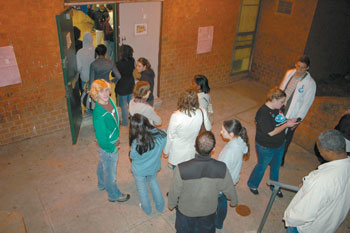All Kristina Jones wanted to do on Election Day was vote.
She fulfilled the requirements to register, but after filling out a provisional ballot, the sophomore art education major isn’t sure if her vote counted.
Jones has doubts about the provisional ballot she filled out. Provisional ballots are used to record a vote when there is question regarding a voter’s eligibility.
According to the Philadelphia Voter Registration Administration, as of Nov. 14, only “some” of the city’s provisional ballots were counted.

Under the Help America Vote Act of 2002, provisional ballots are provided to voters under certain circumstances when an individual claims to be registered but does not appear on the district register, an individual cannot provide an approved form of identification when voting for the first time or an election official rules an individual ineligible to vote.
Any voter who fills out a provisional ballot “must be directed to an accessible area within the polling place where he or she may complete the provisional ballot in private.”
“Everyone else got to go into the little thing where no one else could see,” said Jones, who needed to complete a provisional ballot at the AME Union Church, located at 1614 W. Jefferson St. “They didn’t really help me. They just kind of sat me down and said ‘here.’”
“It took a lot for people to actually get me to vote,” she said. “It felt like such a hassle.”
Once the polls closed, provisional ballot envelopes from each polling place were delivered to the County Board of Elections, which determined whether voters were eligible to vote at the time the provisional ballots were completed.
According to state procedures, the ballots for those voters who were eligible “should be opened and counted.”
A 2006 survey conducted by Project Vote, a nonpartisan, nonprofit organization that helps to “engage low-income and minority voters in the civic process,” showed of the 53,698 provisional ballots completed in Pennsylvania, only 48.6 percent were counted.
Junior finance major Jordan Groff was also required to fill out a provisional ballot because his name could not be found in the district register at the Brown Community Center, located at 1701 N. Eighth St., despite the fact Groff already received his voter registration card.
“I was originally registered to vote at my house in Lancaster,” said Groff, who registered to vote when he turned 18.
He renewed his driver’s license to reflect his off-campus address.
“They automatically updated my registration to [Pennsylvania]. I guess that was the problem,” Groff said.
“It wasn’t private, but I didn’t mind,” Groff said about the space where he completed his provisional ballot. “I was just filling it out on the table with the people working there.”
In compliance with HAVA, voters are required to place their provisional ballots in secrecy envelopes provided by the judge of elections at their polling places. The secrecy envelopes are then placed inside a provisional ballot envelope. On each envelope is a form that must be filled out completely and accurately in blue or black ink.
Jones filled out four voter registration applications in both Pennsylvania and her home state of New York, but she never received a voter registration card.
She registered for the first time in Pennsylvania more than a year ago but “got nothing back,” she said.
After applying for a second time, she said her application was returned through the mail with the word “rejected” stamped on it in red ink.
She then cast an absentee ballot in New York.
As it grew closer to Nov. 4, Jones said she feared an absentee ballot might not be counted. She registered once again in Pennsylvania, just in time for her application to be processed before Election Day.
Jones was told she would be on the polling place’s list of supplemental voters, but once she arrived, her name was not found.
Though she filled out a provisional ballot, she has some doubts about whether it was counted.
Groff said he “didn’t know to” check the status of his ballot because he did not receive a provisional ballot receipt, a slip provided to the voters with their provisional ballot numbers, along with information necessary to determine the status of their ballots.
Jones did not check the status of her ballot, either.
She said she “figured that they only got counted if the vote was close.”
Phil Figueiredo, a junior history major, didn’t expect his provisional ballot to be casted on Election Day.
“My provisional ballot was a complete joke,” said Figueiredo, who had to fill out a provisional ballot at his polling place because his name couldn’t be found on the poll book.
Like Jones, Figueiredo filled out a registration application on the last day Pennsylvania residents could register to vote.
“I was pretty disappointed in the fact that I had to cast a provisional ballot. In a way, I feel like I didn’t even vote,” Figueiredo said. “Election Day was a total downer for me.”
Chelsea Calhoun can be reached at chelsea.calhoun@temple.edu.



Be the first to comment